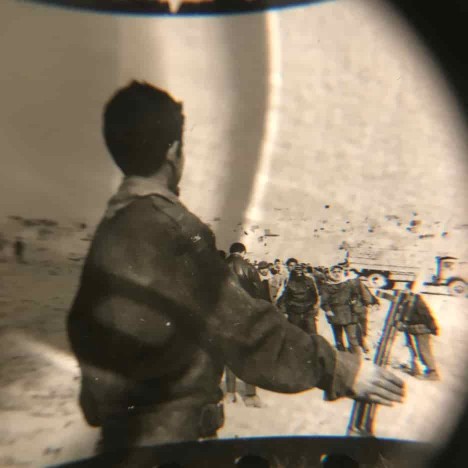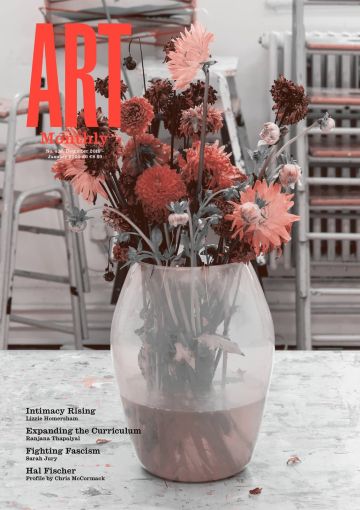Review
The Found Archive of Hani Jawherieh
Amna Malik explores Void Project’s thoughtful feminisation of contested representations of masculinity through the work of the late Palestinian filmmaker.

Hani Jawherieh, Training Camp, Jordan, 1969
A double negative is a grammatical use of two negatives resulting in an affirmative meaning. In the Middle East there are further variations on its use in various dialects. It neatly conveys the complex effect created by Hani Jawherieh’s films, photographs and the re-mediation of his analogue archive through the digital format of this exhibition. Staged as part of the London Palestine Film Festival, it was made possible through the restoration of Jawherieh’s films that were found by his daughter Hiba among the items salvaged by her mother, Hind, on escaping Amman en route to Beirut. The latter became home to the Palestine Film Institute, formerly the Palestine Film Unit, founded by Jawherieh, Sulafa Jadalah and Mustafa Abu Ali in 1968, as part of the PLO, and rooted firmly in the politics of the resistance movement. Its logo of two film reels with a Kalashnikov nestled between them and an olive branch is present in the exhibition amongst a display of contact sheets, a broken camera used by Jawherieh when he was killed by a missile in 1976, and digital screenings of the restored films, including a video-essay produced by the curator Azza El-Hassan in collaboration with Hiba. Watching the film Palestine in the Eye, 1976, produced by Jawherieh’s friends to commemorate his life, creates a sliver of political history for the viewer. Shots taken from Jawherieh’s films of resistance fighters shot from below give a sense of monumentality, and the accompanying voice-over, which uses terms such as ‘the imperialist enemy’ or ‘the capitalist project of the US’, brings to mind, for this reviewer at least, Tricontinentalism, the project of third-world communism that reached its apogee of militant refusal of rampant capitalism in the 1970s. Israel is never mentioned directly, rather the international scope of the resistance movement is emphasised, placing the project within this wider history of a now defunct third-world communism.
The sense of the exhibition conveying a meaning equivalent to a double negative comes about inevitably because of the diminished resources and platforms through which a Palestinian history can be seen. Jawherieh’s death is notable in this regard: the film he was shooting was confiscated by the Israeli military, who then refused to release it, although his camera embedded with shrapnel – with damage to its surfaces – was released to his widow after she requested its return in 1982. The military’s desire to possess this film and prevent it being made public conveys the double or perhaps even multiple levels of negation that Palestinians struggle to overcome when faced with the an imposed representation of their people as being illiterate and ragged peasants which began to circulate in the aftermath of the events of 1967. Israel’s invasion of the West Bank and Gaza is central to the images that Jawhiereh is well known for, particularly of the movement by many Palestinians across the Allenby Bridge. Likewise, the restored film Jersualem, Flowers of all Cities, 1969, is notable for the overlay of a song that evokes the militant poetics of the resistance movement, seen as a nostalgic ode to the city where Jawherieh grew up and from which he was exiled. This is perhaps the most surprising aspect of the exhibition: early photographs by the filmmaker of his everyday life as a resident of Jerusalem, taken during the early to mid 1950s and presented alongside shots of contemporary Jerusalem before and after its invasion by Israel, reveal a multi-faith and cosmopolitan cityscape.
The militant poetics of the PLO within the broader scope of Tricontentinentalism speaks to the centrality of Arab masculinity as the political focus of representation as a site of contestation. But this is offset by a politics of care within a feminist poetics in the exhibition. Reproductions of his photo album as a teenager and subsequently as husband and father, with accompanying hand-written texts, draw out a different register. Restoration and continuity across generations of the Palestinian visual archive is undertaken by the women in Jawherieh’s life and the curator, inserting the feminine and the maternal in the old politics of the left, which nicely complements an apocryphal story: we are told that Jawherieh accompanied every photograph, every significant film shot, with a small dance in celebration, marking the build-up of an archive of a history that was being effaced all around him. If a phenomenological condition of seeing involves the whole body, then the co-equivalence created by the body of the spectator in the exhibition and the act of seeing through Jawherieh’s eyes speaks to the power of the archive as being as much a personal as a collective witness – doubly affirmative.
The Void Project’s ‘The Found Archive of Hani Jawherieh’ took place at P21 Gallery, London, 7–30 November 2019.
Amna Malik is an art historian and writer based in London and Oxford.
First published in Art Monthly 432: Dec-Jan 19-20.











